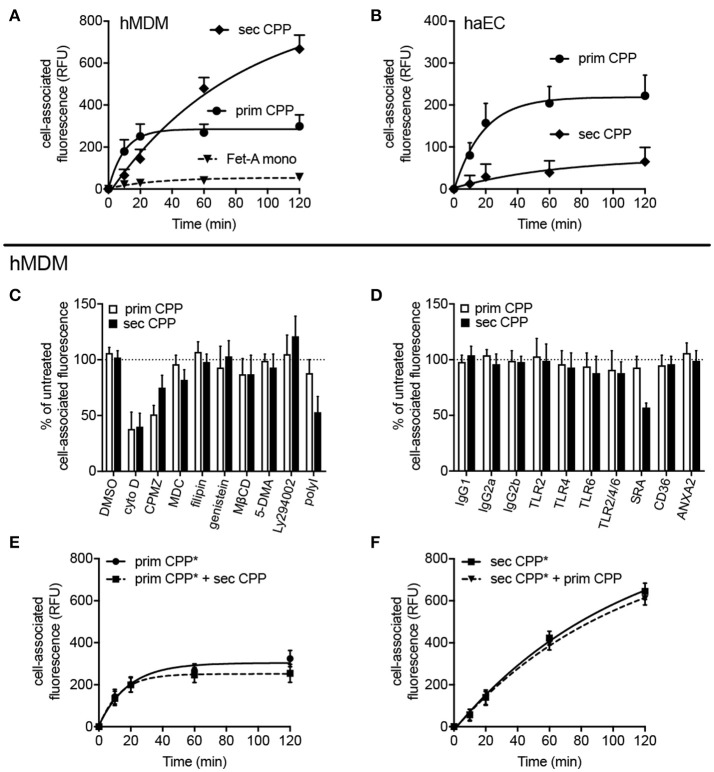Figure 6.
Differential endocytosis of primary and secondary CPP in human monocyte-derived macrophages and aortic endothelial cells. Human monocyte-derived macrophages (hMDM) or human aortic endothelial cells (haEC) were treated with Alexa488-labeled primary or secondary CPP, both 100 μg/mL calcium content, synthesized from FCS/DMEM supplemented with phosphate (final conc. 3.5 mM). Monomeric labeled-fetuin-A was included as a comparator (1 mg/ml). Cell-associated fluorescence was measured by flow cytometry in fixed cells at the stated timepoints. (A) Endocyosis observed in hMDM and (B) haEC, respectively. (C,D) hMDM were pre-treated for 30–60 min with one of several inhibitors (vs. vehicle) or receptor blocking antibodies (vs. isotype control). (C) Pre-treatment with cytochalasin (D), an inhibitor of actin polymerization, markedly attenuated uptake of both primary and secondary CPP and (<50% untreated signal; p < 0.01) indicating the requirement for active actin-mediated cytoskeletal rearrangement for CPP internalization. Inhibition of protein tyrosine kinase/caveolin-dependent endocytosis (filipin and genestein), lipid-raft synthesis (methyl cyclodextrin-β-cyclodextrin; MβCD), macropinocytosis [5-(N,N-dimethyl)amiloride; 5-DMA], and phosphoinositol-3-kinase-dependent Fcγ receptor-mediated endocytosis (Ly294002) all had no significant effect on CPP uptake. Likewise, pre-treatment with monodansylcadaverine (MDC), an inhibitor of clathrin-mediated endocytosis had no effect on particle uptake. Inhibition of clathrin-dependent endocytosis with chlorpromazine significantly reduced primary CPP internalization (<50%; p < 0.05) but not secondary CPP, but may potentially reflect off-target effects due to the non-specificity of the inhibitor. (D) Specific immunochemical blockade of TLR2, TLR4, and TLR6, independently of one another, or in combination failed to significantly inhibit uptake of primary or secondary CPP. Neither blockade of CD36, a class B scavenger receptor involved in the uptake of modified LDL particles, or annexin 2, a putative receptor for fetuin-A cellular attachment, had a significant effect on CPP internalization. Consistent with data in the murine macrophage, competitive chemical inhibition of the SR-A with polyinosinic acid (polyI) or immunochemical blockade, markedly decreased endocytosis of secondary CPP (>50%, p < 0.001), but not primary CPP. (E,F) labeled primary or secondary CPP (CPP*) were added to hMDM with a four-fold excess of unlabeled secondary or primary CPP, respectively to assess whether uptake was competitive. Data are expressed as the mean ±SD, from 6 (A,B,E,F) or 4 (C,D) independent experiments.

